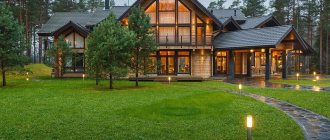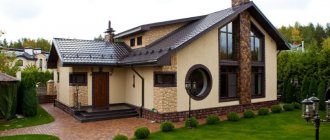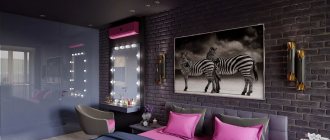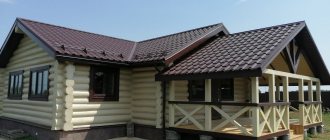It’s quite a difficult task to equip a kitchen with a stove. This may require a large set of finishing materials. In the kitchen, it is necessary to install the stove in such a way as to once again emphasize the interior. To begin with, you should think through everything carefully; you should not lose sight of even small details.
The kitchen is an important place where owners spend a lot of time. It’s good if you can do everything so that it’s comfortable and doesn’t take up much space. Someone decides to install not a real stove, but just for beauty. This would also be a good solution.
A stove is not only a heating device and a means for preparing food, but also an object that creates a special atmosphere.
Russian stoves in the interior
A stove in the interior has great advantages compared to a fireplace: it retains and releases heat for a long time, it does not need to be lit often.
Many models of beautiful Russian stoves are particularly economical and easy to use. It is simply impossible not to adopt such a “miracle unit”. Considering that thoughtful design significantly changes the atmosphere in the house.
Design Features
A Russian stove is easy to recognize by its design features: traditionally it has a stove bench (polati), is quite massive, often with numerous shelves for various kitchen utensils. The cooking chamber is located deep in the oven, so a special grip and skill are required to cook food in it. The basis is a guard; there are usually two dampers for smoke. Between the cooking chamber and the mouth there is a gas threshold, a wall, thanks to which the combustion products are retained under the roof and utilized more completely.
The second important design element is the inflow. It can be completely ordinary or combined with a fireplace.
Also, all furnaces can be classified according to the size of the structure:
- small;
- average;
- big.
A small dacha is often equipped with a compact stove, but a huge country house can be complemented by an unusually large structure of complex design and ornate decor.
Advantages and disadvantages
The stove, conveying the old Russian style, will be an effective addition to many interior compositions. From the point of view of efficiency and functionality, this heating option also has many advantages:
- Long cooling time;
- Good heat conservation;
- High level of efficiency;
- Long service life;
- Design safety.
However, the shortcomings are worth mentioning. The most serious disadvantage is the heat generation higher than 1 m from the floor. However, some improved designs, which involve the installation of a special smoke circulation channel, also allow the floor to be heated.
Also, a stove as a heating device requires a specific type of raw material. Firewood needs to be found, purchased, delivered and storage space organized. Fuel consumption in models of any type is quite high. It is worth considering the fact that not every interior can fit into a stove project in an ethnic direction.
Stove with original tiles
This luxurious stove occupies a central place in the interior. Entering the kitchen, guests immediately notice the unusual decor: tiles made specifically for this stove. In color, they echo both the decoration of the log walls and the ceramic terracotta floor.
Tiles for oven cladding, as a rule, have a relief and are made from baked clay. They are covered with glaze and have a bright design. The back of the tile is a special box with four side walls. This method allows you to better retain the heat generated by the stove.
Materials for the Russian stove
The design of a country house stove will largely depend on the material used. The traditional design was “sculpted” from clay. More modern models were created from brick. Stoves made of cast iron and steel also played an important role.
These are the so-called potbelly stoves. For many, they are associated with something unsightly and rude, but the modern range of mobile and compact heating devices allows you to choose quite sophisticated options.
Brick
Beautiful brick stoves for the home are the dream of true romantics and fans of Slavic flavor. A special advantage of the structures is the “breathable” material. A brick fireplace is a specific microporous body. It releases moisture vapor into the air, and when it cools, it takes it back. A stone heating unit is not capable of this.
A well-designed stove is useful for both heating and cooking. Many models of brick Russian stoves also work as a barbecue or grill.
You can build a brick stove in a small country house or in a luxurious spacious cottage. However, it is better to trust the laying of any type of structure to professionals, avoiding dubious experiments with stove-making amateurs.
Clay
A simple log house of poor people was always complemented by a clay stove. In the modern format, only finishing is made from this material and the sunbed is lubricated. Such a fireplace stove will look luxurious in the interior of a wooden house in a rustic style.
If the heating product is made exclusively on clay, then it will need to be constantly restored. It is necessary to grease and plaster at least once a year.
Cast iron
A wood-burning fireplace made of cast iron has amazing heating properties. The traditional potbelly stove appeared in the 19th century. Initially, such stoves were actively used by the Danes and Germans, and then by the Slavs.
A cast iron fireplace is like a fire: it warms you to the bone if you are in close proximity to it. If you move a decent distance away, the heat will be very soft and delicate. It does not dry out the air.
It is worth noting the disadvantages. Even a relatively small stove with cast iron elements will be very heavy. Huge structures are so heavy that they require strengthening the foundation (in some cases). In addition, cast iron is quite expensive when it comes to expensive materials.
A simple potbelly stove in the interior of a miniature wooden house will always look very stylish. A small unit with ornate “old-fashioned” decor and wooden log walls, a cozy blanket with embroidery and original patterns, indoor flowers - all this will give a person a feeling of calm, relaxation and privacy.
Steel
By analogy with classic cast-iron structures, steel stoves began to be produced. In large units, some elements (for example, the firebox) are replaced with steel ones.
Almost always, the fireboxes of steel furnaces can be lined - they are laid out with fireclay bricks. This is necessary to give the fabric greater heat resistance. You can additionally install tiles on the steel body. It is very fashionable to decorate fireboxes with natural or artificial stone.
Steel structures are much lighter than cast iron prototypes. They are much cheaper, much more mobile in terms of movement (if we are talking about devices like potbelly stoves).
Victorian version
Until the end of the 18th century, people in England cooked on fireplaces. At the same time, the power of the fireplace was determined by its length - the wider the firebox, the more skewers or boilers can be placed in front of the fire. There was only a linear layout.
That is, if we draw an analogy with modern burners, then the only layout solution of that era was to arrange them in one line. So the kitchen fireplaces turned out to be indecently large - to cook soup and boil a kettle.
But then an industrial boom began, and firewood was replaced by high-calorie, but rather smelly coal. We had to come up with a way to protect food from sulfur smoke. Thus began the era of mass production of cookstoves - metallurgy already made it possible to cope with a similar task.
And then the question arose of connecting these slabs to the chimneys. The design is more modest in size than previous fireplaces, but also less demanding on chimneys. And what to do with those fireplaces that have already been built?
The Victorians didn't come up with anything special. They simply slid the new stove into the portal of the old wood-burning fireplace. As a result, the fireplace pipe began to work both as a stove chimney and as an exhaust hood. Very comfortably.
The same can be done today. There is simplicity and versatility here. And if you add modesty to the interior and remove the excessive pomp characteristic of the interiors of that era, you will get a good motif of a rural farm cottage.
Furniture made of simple pine, lattice frames on windows and doors, solid chairs and massive dining tables, monochrome ceramic tiles on the floor or aged floorboards are the main style markers.
Additional materials
Auxiliary parts and additional materials for a traditional Russian stove are not only functional elements, but also serve as effective decor. When working on the creation and design of a stove with a stove bench, you may need the following:
- brick;
- sand;
- accessories for stoves;
- grate;
- valves;
- corners;
- fireclay slabs;
- fireclay brick;
- tile;
- ceramics;
- stone cladding;
- basalt insulation.
The old Russian stove is very economical in everyday life. She will decorate a modern country cottage, and housewives will appreciate her ability to prepare original dishes.
Scandinavian approach
The so-called Scandinavian style - a peculiar elaboration of Provence - allows us to reconcile modernity and archaism. This is northern country, initially focused on modern standards of comfort.
The Scandinavian style is not characterized by technological delights and the contrast of fashionable materials such as glass and steel. This is primarily stone and wood, complemented by a soft natural palette. This setting would suit a rough stone or brick fireplace. A sort of mixture of natural asymmetry and human perfectionism.
Features of masonry
A modern country house requires a special approach to the laying and design of such a complex and powerful heating unit. First they make a backfill - a chamber. It acts as a kind of battery, retaining heat in the house.
The cooking chamber is covered with a roof. It is designed strictly according to the formwork - plank or metal. When laying bricks, they are placed on both sides at once. The angle of inclination will depend on the shape of the arch. This is necessary so that the load is evenly distributed throughout the structure. At the end of the work, the master forms a wedge castle from brick.
The chimney is installed in the furnace itself. The height of the element must be higher than 5 m from the level of the blind hearth. There are no horizontal sections or turns needed. A well-formed vertical (like for a fireplace) is enough.
Quite a village
As already mentioned, whitewashing of stoves began for purely practical reasons. It’s just that the surface that is not finished with anything, bare brick, gives off heat better. So in many country houses, the owners do not even think about masking the brick with anything - its surface itself is very expressive.
The furnishings and decoration in such a house can be subordinated to the idea of an unfinished stove. This does not require any special tricks. Simple wood and plain panels on the walls are enough. But such puritanism can be diluted with contrasting furniture or some decorations on the walls.
This method works especially well in small spaces. Although a large summer kitchen can only benefit from this approach. Moreover, such a project will not require large budget expenditures.
The special charm is that this is almost a panacea for those who like to make things with their own hands, but are little familiar with the stove business - the first independent designs, as a rule, turn out to be rather unsightly in appearance. And this approach allows you to turn the imperfection of form into an advantage.
By playing with shortcomings in this manner, we seem to elevate them to the category of special finds, individual characteristics. Imperfection also has its own, unique beauty.
Where is a Russian stove installed?
In ancient times, at the stage of building houses, they first of all determined where the stove would be located in the house, as well as the bathhouse on the estate. And if not everyone had steam rooms, then they simply could not do without a heating unit.
When choosing the optimal location, the operating principle of the stove, the possibility of further connection of the chimney and ease of maintenance during operation are taken into account. Fire breaks must be calculated - the distance between heating surfaces and walls made of flammable materials.
If the cottage is small, then it is better to place the stove as centrally as possible in the house. The same rule is relevant if the country house is entirely wooden.
In the living room
If the house is large and has many rooms, the ideal place to install the stove is the living room (even if we are not talking about traditional large units, but about miniature potbelly stoves or modern electric fireplaces).
For a large house it is better to create brick structures. Such a stove will warm up spacious rooms well. Typically, the living room is the center of the home.
By placing a stove in it, you can warm up all the rooms. Of course, the design will take quite a lot of time, but it is at the planning stage that it is important to take into account all the subtleties.
For example, to heat a village house consisting of four rooms, the stove is placed at the junction of the two main rooms. The “antique” format of the stove – with a stove bench – will look good in the living room.
Installation in the kitchen
Installation in the kitchen is the second common option for placing a stove in the traditional Russian style. As a rule, this technique is used in several cases:
- Only one room needs to be heated. Usually this is the kitchen or remote living room. A similar need arises when there is a good heating system throughout the house (for example, a gas boiler with a water circuit) and there is a shortage of heat in one of the rooms. Often, it is the kitchen that is being completed or its main structural components are being changed, which requires additional heating.
- A stylish Dutch or Russian “mazanka” skillfully emphasizes a thoughtful interior. Experiments with gastronomic-themed decor and decorations in ethnic style very often go well with the decoration of expensive kitchen locations in country, ethnic, and rustic styles.
- The stove plays the role not so much of a heating device, but rather of a device for cooking. A well-formed design and skillfully selected place will allow you to bake delicious pies, heat a vat of water, experiment with a device with an original barbecue system or grill.
The stove in the kitchen is also located in very small houses. In this case, it is the heating element that becomes the “hot heart” of the whole house. The well-thought-out design of the stove helps to correctly delimit space and divide a compact location into zones.
Country scent
If you have a strong intention of implementing a rustic style in your home, try starting with the scent. Close your eyes and imagine what smell you want to smell. What do you most associate with country life, leisurely and full of pleasures? What do you think it smells like where it’s so good that you don’t want to leave?
If you smell spicy herbs, use Provence style; if your nostrils are tickled by the aroma of hot and baked potatoes, choose country style. Hot pies, honey and autumn apples are a style direction imbued with the spirit of Central Russian open spaces, and the tar smell is characteristic of a Siberian log hut with heavy dark furniture. Rose and sweet pea are the aroma of the English countryside, and the smell of linen and wildflowers is inherent in a modern rustic.
You can bring the appropriate aromas into the house using wooden wall cladding, starched table textiles, flowering indoor plants in pots designed in the style of the interior, decorative details of the kitchen space: bunches of dry herbs, red pepper, coffee decor.
Aromatic impressions, memories in smells are the strongest, deepest and most lasting; they are imprinted into a person’s subconscious. Feeling the long-forgotten aroma that once filled happy days, you will again plunge into a joyful perception of life. Fill your home with this aroma and every time you return there, you will return to the best place on Earth.
How to decorate a stove
There is nothing more original than the use of authentic materials and extravagant techniques in the design of modern apartments. The design of the Russian stove is quite unusual and can complement the beautiful design of the room.
If once the stove played a functional role and was the “center of everyday life” in a home, now its purely aesthetic role has increased. An impressively designed and decorated stove will enrich any modern interior.
Considering the fact that stoves can also be placed on the street, the entire private sector is transformed as soon as a cozy and “elegant” fireplace appears on the site.
Decorating the stove with tiles
Tiles are three-dimensional ceramic tiles that are used for finishing stoves, facades of buildings, and any other structures. The decoration has one distinctive feature - the rump. This is a box with holes through which the decor is attached to the wall.
Tiles come with a smooth surface and a relief canvas, plain and painted with bright patterns, rectilinear design and complex shapes. The decor can be turned into a monochromatic elegant panel or you can create a complex colorful installation with an abundance of decorative techniques.
A special artistic merit of such jewelry is majolica, which can change color at different times of the day. The decoration will show its qualities well in spacious, bright rooms.
The design of a Russian stove using tiled elements has the following advantages:
- Hygiene. They do not accumulate dust and dirt, do not darken over time and are not deformed. The special composition of the glaze does not allow soot and carbon deposits to penetrate inside the decorative ball.
- Highest level of heat capacity. The current eco-friendly format of modern rational heating of housing involves the use of only those heating devices whose efficiency is as high as possible. Tiled decor has a special heat capacity, improving the technical characteristics of the stove as a whole.
- Long heat dissipation. The oven cools down much more slowly.
Decorating a Russian stove with tiles is a complicated matter. Not every stove maker will undertake such work. Ideally, several specialists are involved in the work at once - an experienced stove maker or ceramist, as well as an architect or designer artist.
Plaster and paint
A classically plastered stove looks beautiful and cozy. There are many reasons why the old format of finishing heating units has retained its relevance today:
- Plaster allows you to level even a crooked structure, making the stove more elegant and attractive;
- A beautiful finish gives the old structure a fresh look.
- A large number of types of plastering and a solid range of materials allow us to implement any design project.
The easiest way to decorate a stove after plastering is to whitewash it.
You can do this yourself. A cheap and simple method will not allow you to use the stove to its full potential, since the bleached surfaces will get dirty. Another option (more practical) is the use of paints. If you cover the fireplace with oil and enamel compounds, you can increase heat transfer. Glossy and shiny paints work in the opposite direction. Formulations containing oil may darken under prolonged exposure to high temperatures.
Decorating the stove with tiles
Tiles are an expensive design material for finishing stoves. There is an excellent alternative (more attractive in terms of pricing) - tiles. Tiles or ceramics are presented in such a wide range that such decorative elements can be found in any form. They are suitable for creating unimaginable panels and complex decoration.
Another alternative option is porcelain stoneware or artificial stone. This is a relatively inexpensive material that looks magical in any interior.
The slightly rough textured background is complemented by wooden decorative elements. It turns out very colorful.
Decorate with household items
There are a lot of options for designing a stove in terms of decorative elements. It all depends on the specific stylistic direction in which the stove itself is presented:
- "a la russe";
- hut;
- tower;
- Noble Nest;
- estate in neoclassical format.
An apartment or house decorated using several stylistic concepts at once looks even more interesting. If desired, even a boiler or fireplace corner can be decorated in an incredible way.
Rule of modernity
Today, stove heating is almost exotic. Especially for a city dweller. Accordingly, most people have a stereotype: a stove is an indispensable attribute of rural areas. So any setting of a kitchen room in which there is a stove should, to one degree or another, evoke associations, if not with a dacha, then with some corner of the province. You must definitely feel the rural spirit and mood.
In fact, we simply forget that a stove is a very useful and necessary tool. Therefore, you should not limit yourself to country music or some other pseudo-folk style. You can safely experiment and try to achieve your own special expressiveness.
If a person knows how to choose the design of a bedroom or hallway in an ordinary house, then he can handle a kitchen equipped with a stove.
The only thing to avoid is excessive eclecticism. There is no need to indiscriminately mix styles, schools, directions. Take one line, an idea as the main guide and follow it.
But this does not mean that there is no room for maneuver. This means that the overall image should be complete.
A la russe
The “a la russe” style involves the use of traditional authentic elements of Russian life. Once upon a time, classics were written about stoves with such decor. Shelves were placed near the whitewashed hearth.
Wood is an absolute favorite. The main decorative elements are samovars, brooms and spinning wheels, animal skins (not exotic) and towels with embroidered ornaments. It is not at all necessary to decorate the stove with drawings. A perfect white background is enough.
Russian hut and tower
The stylistic concept of “Russian hut” involves the use of wood. It can only be an imitation, but it must be skillful and thoughtful. In some ways, this direction is reminiscent of a loft, but it is much more dynamic and elegant than the “concrete jungle” style. The main difference from the previous style is that each decorative element has its own functional purpose.
A house in the “Russian tower” style is radically different from other styles. Planning plays an important role here. In villages, many people still decorate their yard in this style. Key features: the presence of garden decor, bright colors, ornate carvings, an abundance of tiles, colorful patterns, bright decor.
Other directions
Traditional Russian stoves with couches in modern apartments are often decorated in ethnic styles, very far from Slavic symbols. The most fashionable formats are oriental and Mexican.
The Russian stove in the interior of houses is a wonderful element that decorates the location and gives the room a unique atmosphere of comfort and homely warmth. With the help of the right design and well-chosen decor, you can turn your home into a real work of art.
Guest house
A dacha is a place of rest. Unfortunately, a person cannot devote most of his life to such an exciting activity. Therefore, a dacha in no way refers to permanent housing - it is a temporary comfort zone.
It makes no sense to spend money on a country house in the same way as on your main home. Country aesthetics are always simpler, less expensive and expressive. Often with a play on rural motifs, the room must nevertheless resonate in spirit with the surrounding landscape.
Actually, the idea of a kitchen as something like a cozy hotel room or guest house comes from the above calculations. A small kitchen-dining room is especially suitable for this look.
Dense arrangement of furniture, minimum decorations. The center of the room is free - a large common table would fit well there. Natural wood color, wooden furniture, floors, frames, ceilings, curtains. Linen curtains or stylized homespun curtains, simple patterns on the fabric and patchwork rugs.
Simplicity here does not mean inconvenience and lack of comfort. This is just an image that disconnects us from the overabundance of city bustle and helps us relax.











